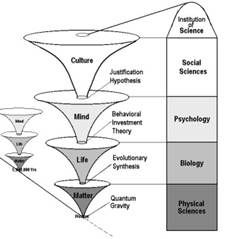Environment
Three Worldviews on the Nature of Consciousness
Supernatural, mystical, and natural views on consciousness
Posted March 7, 2013
It is fairly common to hear psychologists and philosophers comment on what a mystery consciousness is (see here and here for some examples on PT). People have been reflecting for so long on the problem that it is easy to get confused about what the basic issues are—although there certainly are some aspects that are mysterious! Nevertheless, one of the first things to realize is that the concept of consciousness is intimately tied to one’s ultimate worldview. As such, I figured I would take the time to remind readers of the three primary worldviews on the relationship between consciousness and the rest of the universe.
The first and likely oldest and most prevalent worldview can be called supernatural dualism, which is the view of most traditional religions. Supernatural dualism is the notion that there is a spiritual world that is made up of fundamentally different stuff than the physical universe. God, angles, ghosts, are all examples of entities that would exist in the supernatural spirit world. It is easy to know if you are a supernatural dualist. If you believe that your consciousness (or the spiritual essence of your personhood) survives after your body dies, then at some level, you are a supernatural dualist. A recent book, Proof of Heaven, offers a clear articulation of this perspective from a previously skeptical neurosurgeon.
The second worldview can be called parapsychological mysticism, which refers to a belief about a conscious reality that surpasses conventional scientific understanding. The idea here is that consciousness exists as a function of forces that stand in stark contrast to the current scientific understanding of events, and that a true understanding of consciousness will result in a radical revision in modern scientific understanding. Dan Brown’s The Lost Symbol is a good example of a novel based on a mystical interpretation of consciousness. The field of noetic sciences and more generally parapsychology (see here for a recent article on parapsychology in a major journal) argue that the consciousness mind has either an energy or force or field that can interact with matter in a way that would completely upend conventional understanding of the basic physical forces. For a good book on this topic, check out Elizabeth Mayer’s Extraordinary Knowing.
The third perspective is a naturalistic worldview. This is the perspective that consciousness is part of the natural world, is a product of evolution, and emerges as a function of nervous system activity (although see here for a naturalistic position that suggests that bits of consciousness may exist throughout the universe).

The unified theory is an example of a naturalistic approach to consciousness, and it also helps makes clear the importance of dividing the concept of consciousness into two broad domains, with one being the phenomena of mental experience (seeing red, feeling pain) and the other being self-consciousness (“Here I am feeling pain and seeing red”). Most naturalistic views are grounded in a neuro-information processing view where by conscious experience (the first meaning) is considered to be a virtual representation of the animal-environment relationship that functions to enable active behavioral control. Significant progress has been made on understanding the neural correlates of consciousness, the functional connection between perceptions and emotions, and the relationship between conscious and nonconscious cognition. However, as this article by Steven Pinker nicely articulates, the specifics of the neuro-mechanics that actually give rise to “the experience of being” remains highly mysterious. This is what David Chalmers called the ‘hard problem’ of consciousness—no one seems to have a clue as to what and how neurophysiological processes give rise to the experience of seeing red or feeling pain in contrast to the processes that give rise to seeing green or feeling pleasure. I personally envision it in terms of a layering of neural activity that creates a “vacuum” that binds together neuro-electrical waves. Ask me to get specific as to what I mean and my conception will quickly degenerate to babble. They call it the hard problem for a reason!
The bottom line is that if you are chatting with others about the nature of consciousness, it is helpful to get clear as to what worldview everyone is operating from.


